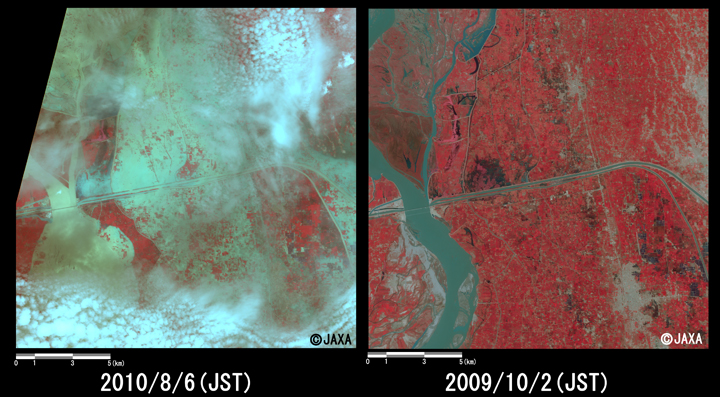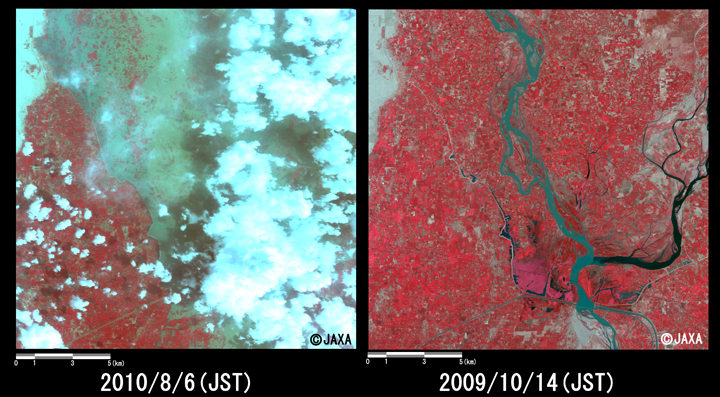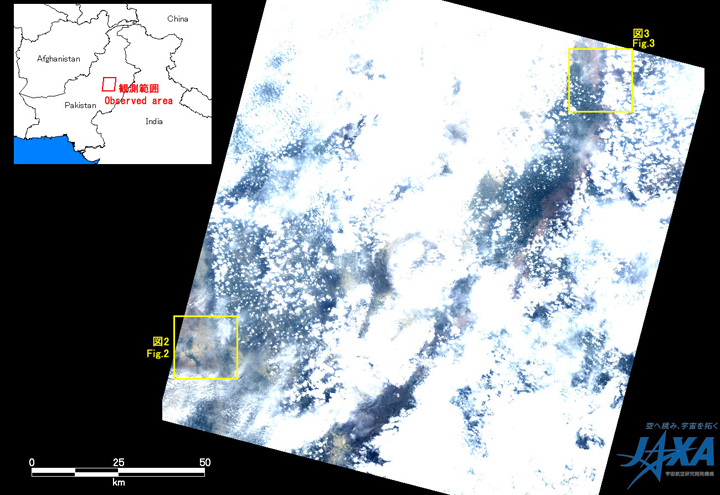Northwestern Pakistan in the central Asia was seriously damaged due to floods and mudslides caused by heavy rain which had occurred since July 29, 2010. The Japan Aerospace Exploration Agency (JAXA) has performed the emergency observation to monitor the state of the damage by the Advanced Visible and Near Infrared Radiometer type 2 (AVNIR-2)* onboard the Advanced Land Observing Satellite (ALOS, "Daichi") at 15:18 (JST) or 6:18 (UTC) on August 6, 2010 further to August 3 and August 5, 2010.
Fig. 1 shows an observed image and is assigned by channel 3, 2 and 1 for red, green and blue colors as true color composite. White colored areas show clouds, swollen rivers and floods at agricultural land could be seen through the clouds.
Fig.1: AVNIR-2 image with 38.0 degrees pointing angle acquired at 15:18 on August 6, 2010 (JST).
Yellow squares show location of Figs. 2 and 3.
(Click to View Enlarged Image)

Fig.2: Enlarged images of the swollen rivers at Shadan Lund
(324 square kilometers, left: August 6, 2010; right: October 2, 2009).
(Click to View Enlarged Image)
Both Figs. 2 and 3 are enlarged images of flooded areas, which were taken after disaster on August 6, 2010 (left), before disaster on October 2, 2009 (right at Fig. 2) and on October 14, 2009 (right at Fig. 3). Figs. 2 and 3 is located at Shadan Lund (360 km south-southwest from Islamabad) and Alhara Hazari (about 260 km south-southwest from Islamabad), respectively. This is assigned band 4, 3 and 2 of AVNIR-2 as the false color composite, therefore vegetation can be seen in red color and flood areas can be seen clear in light gray color. Both Figs. 2 and 3 indicate that agricultural land was widely flooded.

Fig.3: Enlarged images of the swollen rivers at Alhara Hazari
(324 square kilometers, left: August 6, 2010; right: October 14, 2009).
(Click to View Enlarged Image)
JAXA plans continuous observation of this area.
* Advanced Visible and Near Infrared Radiometer type 2 (AVNIR-2):
AVNIR-2 is a visible and near infrared radiometer for observing land and coastal zones.
It provides 10-m spatial-resolution image and 70-km swath on the ground. The pointing angle of AVNIR-2 is +44 and - 44 degrees. This image was acquired by 38.0 degrees east.
[Reference]
2010/8/9: Emergency observation of concentrated heavy rain in Pakistan by AVNIR-2 onboard "Daichi" (ALOS) (2).
2010/8/5: Emergency observation of concentrated heavy rain in Pakistan by AVNIR-2 onboard "Daichi" (ALOS).
©JAXA EORC
